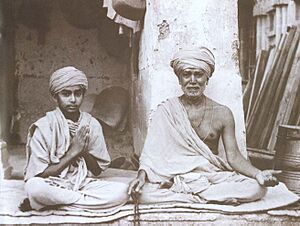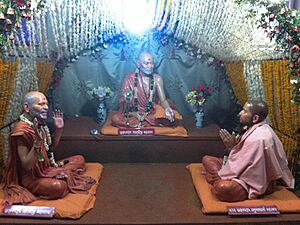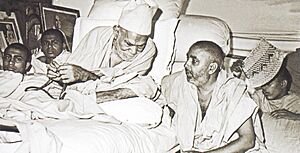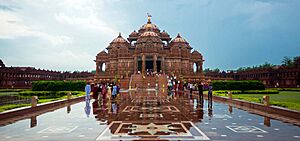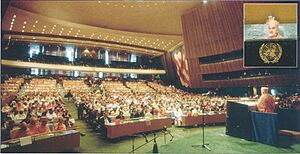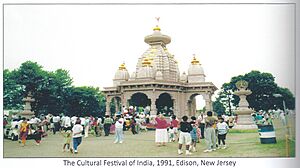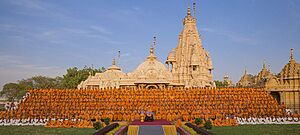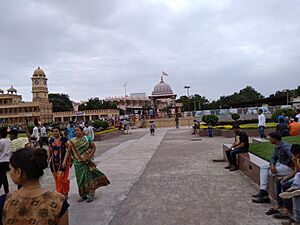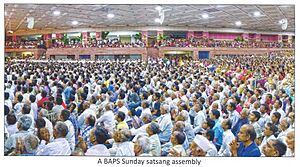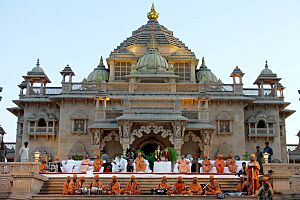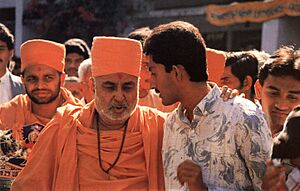Pramukh Swami Maharaj facts for kids
Quick facts for kids Pramukh Swami Maharaj |
|
|---|---|
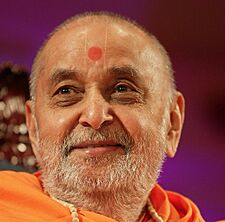
Pramukh Swami Maharaj
|
|
| Birth Date | 7 December 1921 Chansad, Gujarat, India |
| Died on | 13 August 2016 (aged 94) Sarangpur, Gujarat, India |
| Birth name | Shantilal Patel |
| Philosophy | Akshar-Purushottam Darshan |
Pramukh Swami Maharaj (born Shantilal Patel; later known as Narayanswarupdas Swami) was an important spiritual leader. He was the guru (spiritual teacher) and president of the Bochasanwasi Akshar Purushottam Swaminarayan Sanstha (BAPS). This is a major part of the Swaminarayan Sampradaya, a Hindu group.
BAPS followers believe he was the fifth spiritual leader after Swaminarayan. He followed Gunatitanand Swami, Bhagatji Maharaj, Shastriji Maharaj, and Yogiji Maharaj. His followers believed he was always connected to Swaminarayan. They also saw him as a form of Akshar, which is like God's eternal home.
He became a Hindu Swami in 1940. This was under Shastriji Maharaj, who started BAPS. In 1950, Shastriji Maharaj made him the President of BAPS. Later, Yogiji Maharaj said Pramukh Swami Maharaj would be his spiritual successor and the guru of BAPS. He took on this role in 1971.
As president of BAPS, he helped it grow from a group mainly in Gujarat, India, to one all over the world. He built many Hindu mandirs (temples) and centers outside India. He built over 1,100 Hindu temples. This includes the famous Swaminarayan Akshardham temples in New Delhi and Gandhinagar, Gujarat. He also led the work of BAPS Charities, which is BAPS's charity group. Mahant Swami Maharaj became the next guru and president of BAPS after him.
Contents
Early Life and Spiritual Journey
Shantilal was born in a village called Chansad, in Gujarat, on December 7, 1921. His parents, Motibhai and Diwaliben Patel, were followers of Shastriji Maharaj. They believed in the Akshar Purushottam Upasana faith. Both his parents were involved in the Swaminarayan community. His mother's family had been part of it since the time of Bhagatji Maharaj.
Shastriji Maharaj blessed young Shantilal when he was born. He told his father, "This child belongs to us. When the time is right, please give him to us. He will lead thousands to God. Through him, many will find spiritual freedom."
Shantilal's mother said he was a calm and quiet child. But he was also energetic and active. His childhood friends remember him as honest, reliable, mature, and kind. Even as a child, he was very understanding. People trusted his opinions on many things. Shantilal grew up in a simple home. His family did not have much money. He was good at school, but he only went for six years. This was in the seventeen years before he became a swami. As he got older, Shantilal helped his family by doing chores on their farm.
Early Spiritual Interest
Shantilal was interested in spiritual things from a young age. After finishing his schoolwork, he often went to the village's Hanuman temple. There, he and a friend would listen to talks from a Hindu holy man named Haridas.
Shantilal would visit the Swaminarayan temple in Chansad every day for "darshan," which means worship. He also spent time with Shastriji Maharaj and his swami disciples when they visited the village. This showed his strong interest in spirituality. Shantilal would only eat his meals after having darshan at the Swaminarayan temple. He also met other swamis who traveled through the village from holy places in North India. Swaminarayan swamis often visited Chansad. Shantilal regularly helped them during these visits.
As a teenager, Shantilal's connection with Shastriji Maharaj grew stronger. His devotion and intelligence impressed many in the community. Those close to Shantilal felt it was only a matter of time until he would become a monk. He would join the Swaminarayan swamis under Shastriji Maharaj.
Becoming a Monk
On November 7, 1939, when Shantilal was seventeen, he got a letter from his guru, Shastriji Maharaj. The letter asked him to join the swamis. His parents gave their permission and blessings. Shantilal left home that day to join Shastriji Maharaj and his swamis.
Shastriji Maharaj gave Shantilal his first initiation, called parshad diksha. This happened in Ahmedabad on November 22, 1939. He was renamed Shanti Bhagat. One of Shastriji Maharaj's first requests was for Shanti Bhagat to study Sanskrit. Shanti Bhagat followed this wish and did very well in his studies.
Soon after, on January 10, 1940, at the Akshar Deri in Gondal, Shanti Bhagat received bhagvati diksha. He was initiated as a swami and named Narayanswarupdas Swami. This name means "the form of Narayan." When giving him this name, Shastriji Maharaj explained, "His face shows the brightness of God. So I name him Narayanswarupdas (the servant of the form of God)." Yogiji Maharaj also blessed Narayanswarupdasji, saying, "He will surely become great."
Shantilal gave up worldly pleasures. He took vows of celibacy (nishkam), not wanting things (nirlobh), not caring about taste (nisswad), not being attached (nissneh), and humility (nirman). He promised to dedicate his life to God and helping others. Shantilal was a lacto-vegetarian.
Early Years as a Swami
As a young swami, Narayanswarupdas Swami studied Sanskrit and Hindu scriptures. He studied in Bhadaran and Khambhat. He earned the title "Shastri" after mastering both scriptures and philosophy. Besides his studies, Shastri Narayanswarupdas did many activities. These included cleaning temple grounds, cooking for swamis and devotees, and other duties.
Shastri Narayanswarupdas also played a big part in building the Atladra mandir in the early 1940s. During construction, he got chemical burns and blisters from mixing lime. But he kept working without stopping, despite his injuries. He also served as Shastriji Maharaj's personal secretary. This helped him understand BAPS's wider activities. In 1946, when he was 25, Shastriji Maharaj made him the head, or "kothari," of the big BAPS temple in Salangpur. As head of the temple, Shastri Narayanswarupdas managed a large expansion of the temple. This happened even with money problems. His leadership and humble nature during tough times earned him respect. This showed the big responsibility his guru would soon give him.
President of BAPS
Becoming President
In early 1950, Shastriji Maharaj wrote letters to 28-year-old Shastri Narayanswarupdas. He wanted to make him the president of the organization. Twice, Shastri Narayanswarupdas politely said no. He felt he was too young and didn't have enough experience. He also thought there were many older swamis who would be better for the job. But Shastriji Maharaj kept insisting. He sent several senior followers to convince Shastri Narayanswarupdas. Finally, seeing it was his guru's wish, Shastri Narayanswarupdas agreed.
On May 21, 1950, in Ahmedabad, Shastriji Maharaj appointed Shastri Narayanswarupdas as the president ("Pramukh") of BAPS. He was only 28 years old. After this, Shastri Narayanswarupdas became widely known as "Pramukh Swami." At the ceremony, Shastriji Maharaj put his own shawl around Shastri Narayanswarupdas's shoulders. He then asked Yogiji Maharaj to bless him.
Shastri Narayanswarupdas spoke to the group. He said, "I feel so thankful for the kindness and love given to me by my guru, Shastriji Maharaj, and by my mentor Yogiji Maharaj. This day will always be special to me. I am seen as worthy of such great trust by these two noble souls and by all of you, even though I am young." Even after being made president, that evening, Shastri Narayanswarupdas was found washing dishes. These were used by the followers who came to the ceremony. This event showed his humble way of leading, which would continue for the next sixty years.
Working with Yogiji Maharaj
Pramukh Swami Maharaj continued to be the president of BAPS under guru Yogiji Maharaj. This was after Shastriji Maharaj passed away in 1951. He became very respected for his skills in organizing and managing things. He helped Yogiji Maharaj achieve all his goals for the organization. For example, he helped Yogiji Maharaj spread the faith to England and East Africa in the 1960s and 1970s. He also helped build new temples and start new programs. Through all this, he remained humble and never complained about difficulties.
Before he passed away in 1971, Yogiji Maharaj told the swamis and followers, "From now on, Pramukh Swami Maharaj will continue my work. Pramukh Swami is everything to me."
As President and Guru of BAPS
Worldwide Growth
Under Pramukh Swami Maharaj's leadership, BAPS quickly grew into a global Hindu organization. It saw a big increase in many areas. As of 2019, BAPS has over one million followers and more than 900 swamis. It also has 3,300 temples and groups, over 7,200 weekly meetings, and many charity activities. He went with Yogiji Maharaj on a trip to East Africa in 1960 and again in 1970. He made his first overseas trip as the guru, or spiritual leader, of BAPS in 1974. In the years that followed, his 27 international spiritual tours covered over fifty countries on five continents.
Building Temples
On June 4, 1971, in the village of Sankari, he dedicated the first temple after Yogiji Maharaj's passing. After that, he opened hundreds of temples and centers around the world. This led to him being known for dedicating the most Hindu temples. In total, he dedicated 125 temples outside India and 1,000 in India.
Outside India, these temples include large, traditional temples in cities like Houston, Atlanta, Chicago, London, Toronto, and Nairobi. The temple near Atlanta is currently the largest traditional Hindu temple outside India. In India, he inspired the Swaminarayan Akshardham complexes in Gandhinagar and New Delhi. The New Delhi complex is the world's largest complete Hindu temple. Pramukh Swami Maharaj often talked about why building traditional Hindu temples around the world was important. He said these places of worship help teach good values and faith to people in the community.
Promoting Harmony Among Religions
During his international visits, he met with many religious and community leaders. He always stressed what religions have in common. He encouraged them to work together to improve people's moral and religious lives. His message at the 2000 Millennium World Peace Summit at the United Nations was similar. He spoke about cooperation and respect among religions. He said, "religion is that which spreads love for one another." He also wished that all religions could live together peacefully. He noted that "flourishing together is the secret of peace."
He compared every religion to a goldmine of good values. He believed everyone could learn from them. Pramukh Swami also told other spiritual leaders to teach their followers that religion doesn't grow by how many people join. It grows by the quality of their spirituality. He said, "a Hindu should become a better Hindu, a Jew should become a better Jew, a Christian should become a better Christian, a Muslim should become a better Muslim. If the follower of every religion becomes a better and true follower then our world will be a much better world."
This idea of peace through talking was central to his message. During the 2002 Gujarat riots and the Akshardham Temple attack in Gandhinagar, he asked everyone to stay peaceful and united. Leaders praised his actions and guidance during those times. The commander of the rescue mission during the Akshardham attack said, "what [the pramukh] did was unbelievable. He put society back together."
Celebrating Hindu Culture
He led BAPS in holding many large cultural festivals. These events aimed to help people better understand and appreciate Hindu traditions. They also promoted moral and spiritual ways of living. For example, the month-long Cultural Festival of India was held in Edison, New Jersey in 1991. It showed traditional Indian arts, architecture, dance, and music. It also shared Hindu culture and spirituality. Over one million visitors attended, learning about different cultures and faiths.
Initiating Swamis
Pramukh Swami Maharaj began initiating young people into the swami order in January 1971. During his lifetime, he initiated 1,000 young people to become swamis. Many people said his "selfless love" was the main reason they became followers and swamis. After giving up worldly goals, these swamis were guided by him in serving God and society.
Important events included the 200-year celebrations of Swaminarayan in 1981. Also, the 200-year celebrations of Gunatitanand Swami in 1985. On these days, 200 and 173 swamis were initiated in one day. On March 14, 2012, he initiated 68 young people into the monastic order. This ceremony took place in Sarangpur, Gujarat.
Passing Away
In his last days, he was recovering from a chest infection. However, due to his long-standing heart problems, he passed away on August 13, 2016, at 6 pm. This happened at the BAPS Swaminarayan Mandir in Sarangpur, Botad district, Gujarat, India. On July 20, 2012, Pramukh Swami had announced that Mahant Swami Maharaj would be his successor. He would become the sixth guru and spiritual head of BAPS Swaminarayan Sanstha.
His Importance in BAPS
Followers of BAPS believed Pramukh Swami Maharaj was a form of "Akshar." This is like God's eternal home. As Akshar, he was also always connected to God. So, followers saw him as "the perfect servant of God." They believed he was "totally filled with God and therefore worthy of respect and worship."
His Spiritual Role
The living guru is seen by BAPS followers as the perfect swami. He is the ideal follower and the main example for all who seek spiritual growth. Followers often described him as a living example of the holy scriptures. They believed he had reached the highest level of spiritual development.
Devotees thought he showed all the ideals of their religion. They saw him as the first disciple, most faithful to the rules, most active in spreading the religion, and the best at explaining scriptures. He was also seen as the most effective in removing the things that separate people from God. His actions were considered those of the "ideal saint" and "perfect bhakta (devotee)." He provided a clear example for spiritual seekers to follow. Followers saw his deep respect for Shastriji Maharaj and Yogiji Maharaj as the perfect example of devotion to one's guru.
He would carry the murti (holy image) of Swaminarayan in front of him. He would also direct all garlands or offerings given to him to the image. This was seen as a great example of humility and selflessness. Similarly, in September 2002, he asked for peace and forgiveness. This was after an attack on Akshardham Gandhinagar that killed many people. His actions showed the Hindu principle of ahimsa, or nonviolence. His personality and actions served as examples for followers trying to grow personally and spiritually.
Followers believed that by being with him, they could get rid of bad habits and worldly attachments. They believed that earning the guru's grace would help them achieve spiritual freedom. This would allow them to escape the cycle of birth and death and reach "Akshardham" (God's divine home).
For a BAPS follower, he was seen as the vital spiritual link to God. According to Swaminarayan's teachings, followers believe God (Swaminarayan) is present through Pramukh Swami Maharaj. So, his followers believed that by showing devotion to Pramukh Swami, they were showing it to Swaminarayan himself.
Spiritual Guidance
Many followers came to Pramukh Swami for advice on all parts of their lives. Devotees often brought him problems about their personal lives, families, and businesses. They sought his guidance. This kind of communication was an important part of the guru-disciple relationship. So, Pramukh Swami spent a lot of time counseling followers in person, through letters, or by phone. Women could not get advice directly from Pramukh Swami. This was because of his vows as a swami in the Swaminarayan tradition. These vows prevent him from talking directly with women. Women had to ask male relatives to speak to Pramukh Swami for them. Or they would send written messages to ask for advice.
Pramukh Swami told his followers to believe in God. He said that without belief in God's inspiration and faith, nothing is possible. Followers trusted Pramukh Swami's advice because of his spiritual role as guru. They also trusted him because he was seen as a form of Akshar. Also, as someone who had given up worldly things, he was seen as fair. He gained no personal benefit from helping them with decisions.
Pramukh Swami said that the reason he gave advice on so many things was not to help followers get rich. It was to free them from worries about everyday matters. This way, they could focus on their spiritual growth.



